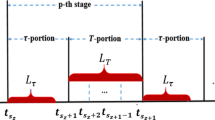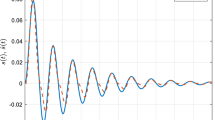Abstract
This paper investigates the fault detection and isolation problem for Takagi–Sugeno fuzzy time-delay systems under the framework of geometric method. First, the geometric concept of unobservability subspace is introduced and the algorithm for constructing the subspace is presented. Then, based on the above algorithm, the faults are divided into the different unobservability subspaces, and the reduced-order subsystems set corresponding to the fault set is constructed according to the geometrical properties of factor space and canonical projection. Finally, a set of structured residuals which are sensitive to a single fault and decoupled from other faults is established by designing an observer for the subsystems. In addition, \(H_\infty\) performance is introduced to attenuate the effects of disturbances and error signals caused by a time-varying delay on the residual. Simulation example verifies the effectiveness of the proposed method.


Similar content being viewed by others
References
Deng, C., Wen, C.: Distributed resilient observer-based fault-tolerant control for heterogeneous multiagent systems under actuator faults and DoS attacks”. IEEE Trans. Control Netw. Syst. 7(3), 1308–1318 (2020)
Li, X.J., Shen, X.Y.: A data-driven attack detection approach for DC servo motor systems based on mixed optimization strategy. IEEE Trans. Ind. Inform. 16(9), 5806–5813 (2020)
Wu, L.B., Park, J.H.: Adaptive fault-tolerant control of uncertain switched nonaffine nonlinear systems with actuator faults and time delays. IEEE Trans. Syst. Man Cybern. Syst. 50(9), 3470–3480 (2020)
Wu, L.B., Park, J.H., Zhao, N.N.: Robust adaptive fault-tolerant tracking control for nonaffine stochastic nonlinear systems with full state constraints. IEEE Trans. Cybern. 50(8), 3793–3805 (2020)
Haj Brahim, I., Chaabane, M., Mehdi, D.: Fault-tolerant control for T-S fuzzy descriptor systems with sensor faults: An LMI approach. Int. J. Fuzzy Syst. 19, 516–527 (2017)
Li, X.J., Yang, G.H.: Adaptive fault-tolerant synchronization control of a class of complex dynamical networks with general input distribution matrices and actuator faults. IEEE Trans. Neural Netw. Learn. Syst. 28(3), 559–569 (2017)
Zhang, Z., Jaimoukha, I.M.: On-line fault detection and isolation for linear discrete-time uncertain systems. Automatica 50(2), 513–518 (2014)
Sina, T.B., Khorasani, K.: Fault detection and isolation of gas turbine engines using a bank of neural networks. J. Process Control. 36, 22–41 (2015)
Ge, H., Yue, D., Xie, X.: Observer-based fault diagnosis of nonlinear systems via an improved homogeneous polynomial technique. Int. J. Fuzzy Syst. 20, 403–415 (2018)
Li, X.J., Yang, G.H.: Fault detection for T-S fuzzy systems with unknown membership functions. IEEE Trans. Fuzzy Syst. 22(1), 139–152 (2014)
Yang, G.H., Wang, H.M.: Fault detection and isolation for a class of uncertain state-feedback fuzzy control systems. IEEE Trans. Fuzzy Syst. 23(1), 139–151 (2015)
Zhai, D., An, L.W., Dong, J.X., Zhang, Q.L.: Simultaneous \(H_2/H_\infty\) fault detection and control for networked systems with application to forging equipment. Signal Process. 125, 203–215 (2016)
Chadli, M., Abdo, A., Ding, S.H.: \(H_-/H_\infty\) fault detection filter design for discrete-time Takagi-Sugeno fuzzy system. Automatica 49(7), 1996–2005 (2013)
Zhai, D., Lu, A.Y., Li, J.H., Zhang, Q.L.: Simultaneous fault detection and control for switched linear systems with mode-dependent average dwell-time. Appl. Math. Comput. 273, 767–792 (2016)
Jee, S.C., Lee, H.J.: Sampled-data \(H_-/H_\infty\) fault detection and isolation for nonlinear systems in T-S form: An approximate model approach. Fuzzy Sets Syst. 297, 112–127 (2016)
Murray, W.W.: Linear Multivariable Control: A Geometric Approach. Springer, New York (1979)
Isidori, A.: Nonlinear Control Systems. Springer, New York (2013)
De Persis, C., Isidori, A.: A geometric approach to nonlinear fault detection and isolation. IEEE Trans. Autom. Control 46(6), 853–865 (2001)
Bokor, J., Balas, G.: Detection filter design for LPV systems–a geometric approach. Automatica 40(3), 511–518 (2004)
Kabore, P., Hammouri, H., Kinnaert, M.: A geometric approach to fault detection and isolation for bilinear systems: application to heat exchangers. IFAC Proceedings Volumes 33(11), 249–254 (2000)
Meskin, N., Khorasani, K.: Robust fault detection and isolation of time-delay systems using a geometric approach. Automatica 45(6), 1567–1573 (2009)
Han, L., Qiu, C.Y., Xiao, J.: Finite-time \(H_\infty\) control synthesis for nonlinear switched systems using T-S fuzzy model. Neurocomputing 171, 156–170 (2016)
Zhang, Z.Y., Lin, C., Chen, B.: New results on \(H_\infty\) filter design for nonlinear time-delay systems via fuzzy line-integral approach. Int. J. Fuzzy Syst. 18(5), 904–913 (2016)
Shen, Q.K., Jiang, B., Cocquempot, V.: Fault-tolerant control for T-S fuzzy systems with application to Near-Space hypersonic vehicle with actuator faults. IEEE Trans. Fuzzy Syst. 20, 652–665 (2012)
Li, X.J., Yang, G.H.: Fault detection in finite frequency domain for Takagi-Sugeno fuzzy systems with sensor faults. IEEE Trans. Cybern. 44(8), 1446–1458 (2014)
Liu, L., Yin, Y.F., Wang, J.H., Wu, Q.H.: Stability analysis of discrete-time switched nonlinear systems via T-S fuzzy model approach. Neurocomputing 173, 1967–1971 (2016)
Ma, H., Li, H.Y., Lu, R.Q., Huang, T.W.: Adaptive event-triggered control for a class of nonlinear systems with periodic disturbances. Sci. China Inf. Sci. 63(5), 1–15 (2020)
Pan Y.N., Du, P.H., Xue, H., Lam, H.K.: Singularity-free fixed-time fuzzy control for robotic systems with user-defined performance. IEEE Trans. Fuzzy Syst. https://doi.org/10.1109/TFUZZ.2020.2999746.
Du, P.H., Pan, Y.N., Li, H.Y., Lam, H.K.: Nonsingular finite-time event-triggered fuzzy control for large-scale nonlinear systems. IEEE Trans. Fuzzy Syst https://doi.org/10.1109/TFUZZ.2020.2992632
Li, Y.M., Sun, K.K., Tong, S.C.: Observer-based adaptive fuzzy fault-tolerant optimal control for SISO nonlinear systems. IEEE Trans. Cybern. 49(2), 649–661 (2019)
Li, Y.M., Ma, Z.Y., Tong, S.C.: Adaptive fuzzy fault-tolerant control of non-triangular structure nonlinear systems with error-constraint. IEEE Trans. Fuzzy Syst. 26(4), 2062–2074 (2018)
Li, Y.M., Tong, S.C.: Adaptive neural networks decentralized FTC design for nonstrict-feedback nonlinear interconnected large-scale systems against actuator faults. IEEE Trans. Neural Netw. Learn. Syst. 28(11), 2541–2554 (2017)
Zhu, Z.C., Pan, Y.N., Zhou, Q., Lu, C.X.: Event-triggered adaptive fuzzy control for stochastic nonlinear systems with unmeasured states and unknown backlash-like hysteresis. IEEE Trans. Fuzzy Syst. https://doi.org/10.1109/TFUZZ.2020.2973950
Wang, X.L., Yang, G.H.: Fault detection for T-S fuzzy systems with past output measurements. Fuzzy Sets Syst. 365, 98–115 (2019)
Zhai, D., An, L.W., Li, J.H., Zhang, Q.L.: Finite frequency fault detection for T-S fuzzy singular multiple timedelay systems. Int. J. Control Autom. Syst. 14(4), 977–985 (2016)
Dong, H.L., Wang, Z.D., Lam, J., Gao, H.J.: Fuzzy-model-based robust fault detection with stochastic mixed time delays and successive packet dropouts. IEEE Trans. Syst. Man Cybern. 42(2), 365–376 (2012)
Jee, S.C., Lee, H.J.: \(H_-/H_\infty\) fault detection and isolation for nonlinear systems with state delay in T-S form. J. Franklin Inst. 353(9), 2030–2056 (2016)
Li, L., Chadli, M., Ding, S.X., Qiu, J., Yang, Y.: Diagnostic observer design for T-S fuzzy systems: application to real-time-weighted fault-detection approach. IEEE Trans. Fuzzy Syst. 26(2), 805–816 (2018)
Li, L., Ding, S.X., Qiu, J., Yang, Y., Xu, D.: Fuzzy observer-based fault detection design approach for nonlinear processes. IEEE Trans. Syst. Man Cybern. 47(8), 1941–1952 (2017)
Islam, S.I., Lim, C., Shi, P.: Robust fault detection of T-S fuzzy systems with time-delay using fuzzy functional observer. Fuzzy Sets Syst. 392(1), 1–23 (2019)
Author information
Authors and Affiliations
Corresponding author
Appendices
Appendix A: Proof of Lemma 3
Proof
First, for any \({\mathscr {Z}}\in {\mathscr {J}}\) that satisfies \((A_i+D_iC){\mathscr {Z}}\subseteq {\mathscr {Z}}\) and \((A_{\tau i}+D_{\tau i} C){\mathscr {Z}}\subseteq {\mathscr {Z}}\), we have
The same as above, we have \((A_{\tau i}+D_{\tau }C){\mathscr {Z}}\subseteq {\mathscr {Z}}\), where \({\mathscr {S}}\subseteq {\mathscr {Z}}\), hence \({\mathscr {Z}}\in {\mathfrak {W}}^{s}\). then we have \({\mathscr {Z}}^*\in {\mathfrak {W}}^{s}\). In addition, obviously if \({\mathscr {V}}\subseteq {\mathscr {S}}\), then \({\mathscr {V}}\subseteq {\mathscr {Z}}^*\) since \({\mathscr {S}}\subseteq {\mathscr {Z}}^*\). Consider the case of \({\mathscr {S}}\subseteq {\mathscr {V}}\), we have
We consider the facts that \({\mathscr {V}}\subseteq (A_i+D_i)^{-1}{\mathscr {V}}\) and if \({\mathscr {S}}\in {\mathscr {V}}\), then \({\mathscr {S}}+({\mathscr {V}}\cap \ker C)={\mathscr {V}}\cap ({\mathscr {S}}+\ker C)\). Clearly that \({\mathscr {V}}\subseteq {\mathscr {Z}}_0\). From the two facts, it can be concluded that if \({\mathscr {V}}\subseteq {\mathscr {Z}}_{k}\), then
Consequently, \({\mathscr {V}}\subseteq {\mathscr {Z}}_{k+1}\), and \({\mathscr {V}}\subseteq {\mathscr {Z}}^*\), then we have \({\mathscr {Z}}^*=\ll {\mathscr {S}}+\ker C|(A_i+D_iC),(A_{\tau i}+D_{\tau i} C)\gg _{i\in \{1\cdots s\}}\). \(\square\)
Appendix B: Proof of Lemma 4
Proof
First let us prove the “if” part. If \({\mathscr {S}}\in {\mathfrak {W}}^{s}\) and \({\mathscr {S}}={\mathscr {Z}}^*\) hold, then it can be got that \({\mathscr {S}}=\ll {\mathscr {S}}+\ker C|(A_i+D_iC),(A_{\tau i}+D_{\tau i}C)\gg _{i\in \{1\cdots s\}}\) according to Lemma 3. From Lemma 2. one gets \({\mathscr {S}}\in {\mathfrak {S}}^{s}\).
Now let us prove the “only if” part, if \({\mathscr {S}}\) is an unobservability subspace, we have \({\mathscr {S}}\in {\mathfrak {W}}^{s}\), and according to Lemma 3, one gets \({\mathscr {S}}={\mathscr {Z}}^*\). \(\square\)
Rights and permissions
About this article
Cite this article
Liu, H., Li, XJ. Fault Detection and Isolation of T–S Fuzzy Systems with Time-Delay Using Geometric Approach. Int. J. Fuzzy Syst. 23, 937–946 (2021). https://doi.org/10.1007/s40815-020-01023-4
Received:
Revised:
Accepted:
Published:
Issue Date:
DOI: https://doi.org/10.1007/s40815-020-01023-4




